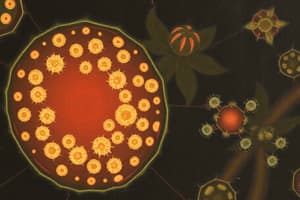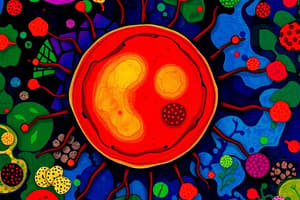Podcast
Questions and Answers
What is a cytologist?
What is a cytologist?
A person who studies cells
What is cytology?
What is cytology?
Study of cells
What is the smallest living thing?
What is the smallest living thing?
Cell
What does cell theory state?
What does cell theory state?
What are prokaryotes?
What are prokaryotes?
What characterizes eukaryotes?
What characterizes eukaryotes?
What is a bacterium?
What is a bacterium?
What are protists?
What are protists?
What is an amoeba?
What is an amoeba?
What is euglena?
What is euglena?
What is volvox?
What is volvox?
What are flagella?
What are flagella?
What are cilia?
What are cilia?
What are pseudopods?
What are pseudopods?
Flashcards are hidden until you start studying
Study Notes
Cytology Overview
- Cytology refers to the study of cells, encompassing their structure, function, and behavior.
- A cytologist is a specialist who performs research and analyses related to cell biology.
Fundamental Concepts
- The cell is recognized as the smallest unit of life, essential for all biological systems.
- Cell theory highlights three core principles:
- All living organisms are composed of one or more cells.
- The cell is the fundamental unit of life.
- Cells arise solely from pre-existing cells.
Cell Types
- Prokaryotes: Simple, single-celled organisms lacking a nucleus and membrane-bound organelles.
- Eukaryotes: More complex cells that contain a nucleus and various membrane-bound organelles.
Specific Organisms
- Bacteria: A category of prokaryotic organisms that are single-celled and move utilizing flagella.
- Protists: A diverse group of generally simple eukaryotic organisms that possess a nucleus.
Notable Eukaryotic Organisms
- Amoeba: A single-celled eukaryotic organism characterized by its ability to move using pseudopods, which are temporary projections of the cell.
- Euglena: Another single-celled eukaryotic organism that moves by means of flagella, showcasing both plant and animal traits.
- Volvox: A type of eukaryotic organism that forms colonies by grouping together, capable of photosynthesis due to its chloroplasts.
Cell Movement Structures
- Flagella: Tail-like structures that propel cells, primarily seen in bacteria and euglenas.
- Cilia: Hairlike structures found on some cells (like paramecium) that facilitate movement by beating in a coordinated manner.
- Pseudopod: A form of locomotion used by amoebas, involving the extension of the cell's cytoplasm to move and capture food.
Studying That Suits You
Use AI to generate personalized quizzes and flashcards to suit your learning preferences.




